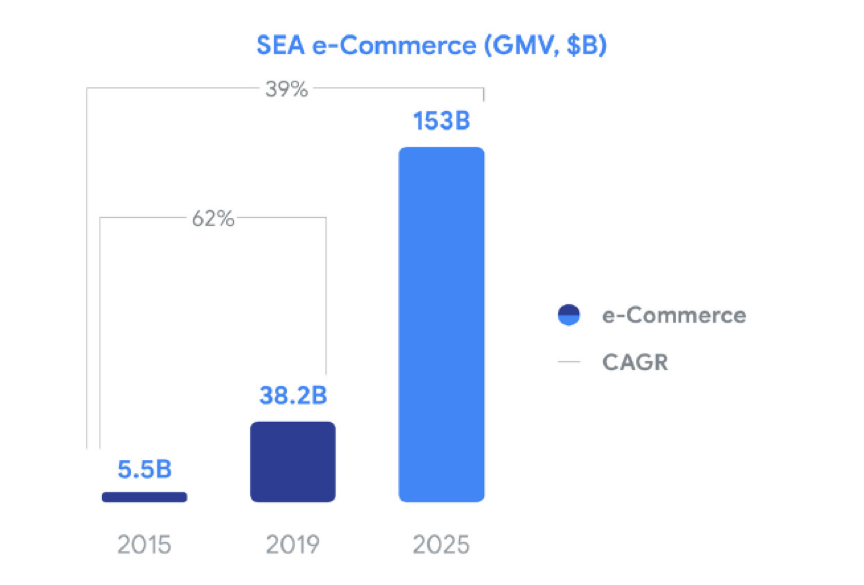Southeast Asia’s e-commerce scale reached 38 billion US dollars
Editor’s note: This article comes from WeChat public number “7:5 Degree” (ID: Asia7_5).
At present, e-commerce has surpassed online travel and has become the most valuable area of the Internet economy in Southeast Asia. In just four years, the growth trajectory of e-commerce has been hyperbolic, jumping from $5.5 billion in 2015 to more than $38 billion in 2019, an increase of nearly seven times. By 2025, the industry is expected to exceed $150 billion, a significant increase of $50 billion from a year ago.
Online shopping festivals promote the growth of e-commerce purchasing power
E-commerce offers Southeast Asians the opportunity to reach out to the global marketplace, offering value, selectivity and convenience that traditional stores can’t match. At the same time, the combination of excitement and entertainment elements brought by shopping consumption has become a unique social experience.
In addition, the online e-commerce store’s overwhelming promotion gives consumers the reason to “snap” on e-commerce apps and websites – in the US, there is Black Friday; in Southeast Asia, there are more online shopping spree. Festival: From the 99 Shopping Festival (September 9th) and the Singles Day (November 11th) to the Double 12 (December 12th), it seems that the discount season has been ongoing. According to Google Trends, during the online shopping festival, consumers have more than doubled the number of e-commerce sellers who have received replacement vouchers and coupons over the past four years.
Southeast Asia e-commerce has entered a new era of live and gamification
Southeast Asia’s head e-commerce players are using entertainment as a promotional strategy. For example, some apps add live video features, mainly webcast live out of the box and evaluate their favorite brands. Others provide shoppers withThe opportunity to chat and participate in online auctions makes the purchase process more interactive. This method has gained widespread attention, especially in Vietnam and Indonesia.
Many of these new attempts are combined with the elements of “gamification.” For example, a user may invite others to make a group purchase at a lower group purchase price. In the game, this is equivalent to playing a group. E-commerce gamification strategies also help e-commerce gain more valuable insights based on consumer behavior and preferences, helping e-commerce companies optimize their services and products through machine learning.
The platform is not just for driving demand. E-commerce companies recognize that users have a lot of shopping options, so they also focus on the supply side, ensuring that there are enough quality products on the platform that come from brand direct supply or from reliable sellers. For Southeast Asian head players, considering that sellers tend to be more “sticky” to the platform than their users, it is a key strategy to work with sellers to increase sales and profits.
Supply chain and logistics construction can’t be ignored
The platform is not just for driving demand. E-commerce companies recognize that users have a lot of shopping options, so they also focus on the supply side, ensuring that there are enough quality products on the platform that come from brand direct supply or from reliable sellers. For Southeast Asian head players, considering that sellers tend to be more “sticky” to the platform than their users, it is a key strategy to work with sellers to increase sales and profits.
Building a reliable logistics network covering the entire country has always been the main goal of e-commerce players in the region. Now, companies are racing to speed up delivery. Many e-commerce participants are moving in the direction of the next day. Some players have also launched the service of the day in several cities to meet the willingness to pay a fare increase in order to receive fresh and urgent items within 24 hours. Consumer.
The way out for e-commerce
Because of these innovative initiatives, consumers have undergone a fundamental shift in their behavior when shopping online. In the past, online shopping was to buy high-priced goods such as TVs or smartphones at a low price. Nowadays, e-commerce has become a daily shopping behavior, with an average of more than 5 million orders per day. Daily necessities, personal care and beauty products are becoming the basic products in Southeast Asian online shopping carts. As a result, the average order amount (AOV) or consumer spending for each order has fallen between $15 and $20. This figure is about a quarter of the average order value (AOV) for developed markets. In areas with low levels of urbanization, this price may be lower, below $10.
For e-commerce players, keeping the freight price reasonable while maintaining profitability is a huge challenge. As a result, more and more companies are turning to the supply side to maintain growth, such as adding value to platform sellers.Service fees, logistics and inventory management fees, and advertising fees. Today, the e-commerce sector is growing exponentially, and how to cash in is the key to winning this e-commerce game.
编 | 云晞@出海



